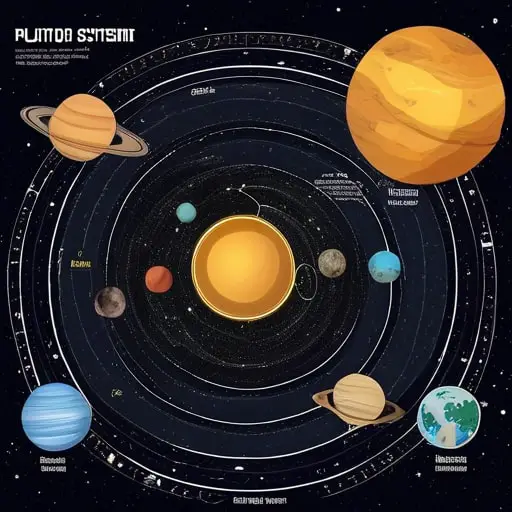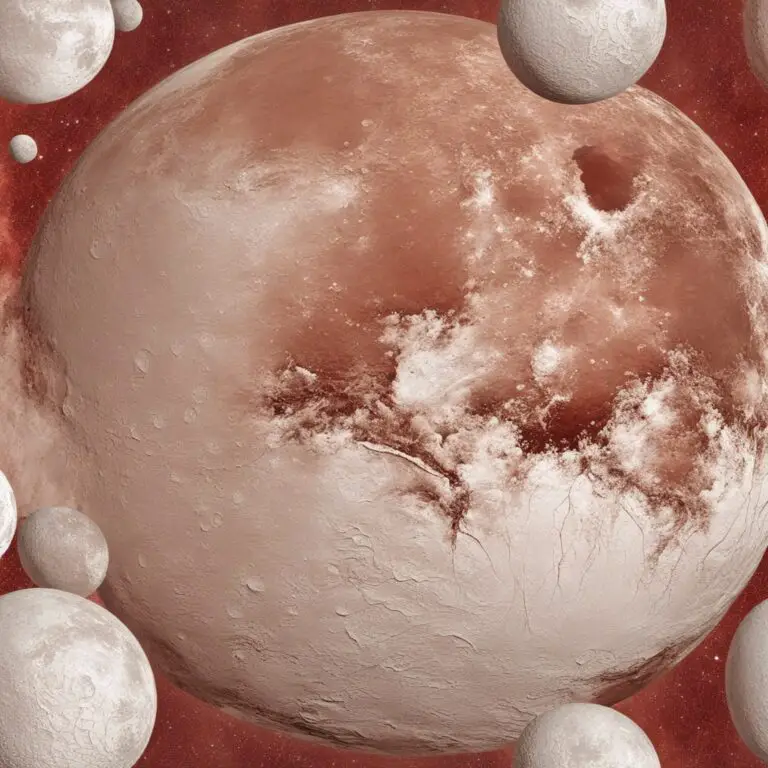How Did Pluto Get Its Name?
Have you ever wondered how celestial bodies get their names?
Take Pluto, for example. Its name has a fascinating origin that involves the influence of mythology and the involvement of an 11-year-old girl. But how did this young girl’s curiosity and love for mythology play a role in naming a distant dwarf planet?
In this discussion, we will delve into the story behind how Pluto got its name and the legacy it leaves behind.
So, let’s embark on this journey and uncover the intriguing tale of how Pluto came to be known as Pluto.
Key Takeaways
- Pluto was discovered by Clyde W. Tombaugh in 1930 during his search for Planet X beyond Neptune.
- The name ‘Pluto’ was suggested by an 11-year-old girl named Venetia Burney, and it was adopted by the Lowell Observatory and accepted by the International Astronomical Union.
- The naming process for Pluto and its moons involved the influence of Roman gods and Greek mythology, with celestial objects named after figures associated with the underworld.
- The involvement of a young girl in the naming process and the public reaction to the name added to the fascination and intrigue surrounding Pluto.
Discovery of Pluto’s Existence
Pluto’s existence was discovered by Clyde W. Tombaugh on February 18, 1930, during his search for Planet X beyond Neptune.
Tombaugh, working at the Lowell Observatory in Flagstaff, made this groundbreaking discovery using photographic plates. His meticulous analysis of the images revealed a faint object moving against the backdrop of the stars, indicating the presence of a previously unknown planet.
This momentous finding marked the culmination of Percival Lowell’s vision and the tireless efforts of the observatory’s astronomers. The discovery of Pluto’s existence sparked worldwide interest and excitement, as it added a new member to our solar system’s planetary family.
The name ‘Pluto’ was suggested by Venetia Burney, an eleven-year-old schoolgirl from Oxford, England, and was chosen from among a thousand suggestions.
The discovery of Pluto’s existence solidified our understanding of the vastness and complexity of our celestial home.
Initial Naming Controversies
After the discovery of Pluto’s existence, the astronomy community and the public engaged in lively discussions and debates regarding its initial naming.
The spirited battle over what to call this newly discovered celestial object revealed the strong interest and significance attached to it.
Venetia Burney, an 11-year-old girl, suggested the name ‘Pluto’ based on her knowledge of Greek and Roman legends. The Lowell Observatory, which made the discovery, eventually adopted this name amidst a list of other potential names, including Kronos, Minerva, Zeus, Atas, and Persephone.
The choice of ‘Pluto’ highlighted its association with the Roman god of the underworld, adding to the excitement and intrigue surrounding this distant object.
Ultimately, Burney’s suggestion became the official name, and it was widely accepted by the International Astronomical Union (IAU). This initial naming controversy left a lasting legacy and sparked scientific debates about Pluto’s classification.
Influence of Mythology and Roman Gods
The influence of mythology and Roman gods played a significant role in the naming of Pluto, the distant planet now known for its cold, dark, and mysterious nature. Here are three key points to consider:
- The name Pluto was chosen as a homage to the Roman god of the underworld. This association with the realm of darkness and the afterlife aligns with the planet’s distant and enigmatic characteristics.
- The name Pluto also honors Percival Lowell, the astronomer who sparked the search for the unknown planet. His dedication to the study of the outer solar system led to the eventual discovery of Pluto.
- The naming process involved the Lowell Observatory, which received numerous suggestions from around the world. After considering 1,000 proposals, they ultimately settled on the name Pluto, solidifying its connection to Roman mythology and the underworld.
The naming of Pluto and its moons after mythological figures associated with the underworld, such as Charon, Nix, Hydra, Kerberos, and Styx, further emphasizes the influence of Roman gods and Greek mythology in the naming conventions of celestial objects.
The Role of an 11-Year-Old Girl
Drawing from her knowledge of Greek and Roman mythology, an 11-year-old girl named Venetia Burney suggested the name Pluto for the newly discovered planet.
Her suggestion was influenced by the god of the underworld in classical mythology. The name Pluto not only paid homage to the mythology but also honored Percival Lowell, who initiated the search for Planet X.
Among over 1,000 worldwide suggestions, Venetia Burney’s idea won the vote, highlighting the significance of her contribution. This contribution is further recognized through the instrument named after her on the New Horizons mission.
However, in 2006, the International Astronomical Union redefined planets and reclassified Pluto as a dwarf planet. Nevertheless, Venetia Burney’s role in naming Pluto remains an important part of its history.
| Facts |
|---|
| Venetia Burney suggested the name Pluto |
| Pluto named after the god of the underworld |
| Pluto also honors Percival Lowell |
| Venetia Burney’s suggestion won the vote |
| Her contribution is recognized through the New Horizons mission |
| Pluto reclassified as a dwarf planet in 2006 |
The Final Selection Process
Following the important contribution of Venetia Burney in suggesting the name Pluto, the final selection process for naming celestial objects is overseen by the International Astronomical Union (IAU).
The IAU, serving as the final arbiter in this process, ensures consistency and standardization in the naming of celestial bodies. Astronomers and scientists adhere to the guidelines set by the IAU when proposing and selecting names for celestial objects, including the planet Pluto, once considered the ninth planet in our solar system.
The IAU’s decisions regarding names are widely accepted in the scientific community, and its role is crucial in maintaining order and coherence in celestial object nomenclature.
By overseeing the final selection process, the IAU helps prevent confusion and ensures that the names chosen, such as Pluto, are appropriate and meaningful.
Public Reaction to the Name
Public reaction to the name ‘Pluto’ was filled with lively discussions and interest among both the astronomy community and the general public. The naming of Pluto sparked spirited debates among astronomers, who considered various potential names.
Ultimately, the suggestion of the name ‘Pluto’ by 11-year-old Venetia Burney won the vote and became the official name.
This decision highlighted the significance and excitement surrounding the discovery of this enigmatic dwarf planet. Burney’s legacy is well-documented in the popular press, and her contribution to the naming of Pluto is honored through an instrument on the New Horizons mission named after her.
The involvement of a young girl in the naming process captured the public’s imagination and added to the fascination with this celestial body.
The public’s reaction to the name ‘Pluto’ was contextually relevant, reflecting the widespread interest in the exploration of our solar system.
Legacy of Pluto’s Name
The significance and excitement surrounding the discovery of Pluto is further emphasized by the lasting legacy of its name.
The name Pluto was chosen for this distant and mysterious celestial body to honor the Roman god of the underworld. This connection to darkness and night adds to the intrigue and mystique surrounding Pluto.
The name was suggested by an 11-year-old girl named Venetia Burney, who saw the similarity between the planet’s distance from the sun and its association with the underworld.
The name also serves as a tribute to Percival Lowell, with the first two letters representing his initials, recognizing the important role played by the Lowell Observatory in the discovery.
The name Pluto prevailed over other potential options, leaving a lasting legacy that reflects the significance of this celestial body.
As a side note, if you’re curious about the time it takes for Pluto to complete one orbit around the sun, you can use the Pluto time calculator to precisely determine the years, months, and days involved in its mysterious journey through the outer reaches of our solar system.
Frequently Asked Questions
How Did Pluto Got Its Name?
Pluto got its name from an 11-year-old girl named Venetia Burney who suggested it. The name honors Percival Lowell, the astronomer, and is derived from classical mythology.
Why Was Pluto Named After Hades?
Pluto was named after Hades, the god of the underworld, because of its dark and distant nature. Astronomers at the Lowell Observatory chose the name, inspired by Greek mythology and in honor of Percival Lowell.
What Was Pluto Named Based On?
Pluto was named based on its connection to the god of the underworld, chosen from a pool of suggestions worldwide. Its name honors Percival Lowell, and reflects the excitement surrounding its discovery.
Who Discovered Pluto and Named It?
You discovered Pluto and named it, Clyde W. Tombaugh. Your incredible find in 1930 led to its classification as the ninth planet. Its name, suggested by an 11-year-old girl, honors the god of the underworld.
Conclusion
In conclusion, the naming of Pluto was a result of the curiosity and love for mythology held by a young girl named etia Burney. Her contribution to the selection process will forever be remembered as she suggested the name of the distant dwarf planet, influenced by Roman gods.
This case study showcases how even the smallest voices can have a significant impact on scientific discoveries and the legacy of their names.











